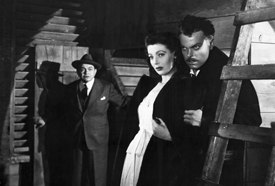Following five years after his groundbreaking CITIZEN KANE, this thriller was Orson Welles only theatrical hit. He was inspired to make the film after seeing documentary footage of the liberation of the concentration camps. He believed reforms in post-War Germany were pointless, because the “putrefaction of the soul” that was Nazi ideology was just waiting to fuel another fire.
In the film, Welles plays Nazi-in-hiding Franz Kindler. The young architect of genocide has become a professor in America under the name of Prof. Charles Rankin. His cover is perfect; he’s about to marry Mary Longstreet (Loretta Young, THE BISHOP’S WIFE), the daughter of Judge Adam Longstreet (Philip Merivale, NOTHING BUT TROUBLE). But he’s about to fall into a trap set by Mr. Wilson (Edward G. Robinson, DOUBLE INDEMNITY), an officer of the United Nations War Crimes Commission. He has let free Kindler’s confident Konrad Meinike (Konstantin Shayne, VERTIGO), who leads him right to Kindler.
In 1946 when this film first arrived it was certainly more daring. The Nazi threat had only just been defeated and Nazi leaders were still on the loose. Welles wanted to open up people's eyes. In one scene, he has Mr. Wilson force Mary to watch concentration camp footage, which in turn forced the audience. He wasn't going to allow people to put blinders on about the issue. In another scene, he has Kindler tell his thoughts on the German people's psyche at a dinner party. As Rankin, he can put the vale of scholarly psychological philosophy on top of his own beliefs in the German superior status. But he slips up and when asked about Karl Marx, he says, "He's not a German. He's a Jew."
But that misstep isn't enough for Mr. Wilson to haul him away, he needs proof. He needs Mary to turn on her new husband, but Kindler has already started working his psychological game on her, making her believe the world is against the two of them. So Wilson first enlists her smart younger brother Noah (Richard Long, HOUSE ON HAUNTED HILL) and then her father. They fear for her life, because if he has to Kindler will kill her.
Welles crafts Kindler as a master manipulator. This is all the more sinister in how easily he weaved his way into the top tier of the small town he hides out in. He's also teaching young people. Fresh minds to possible indoctrinate with the disease of Nazism. Welles plays him as a man on the edge, desperately trying to keep up appearances in order to survive.
Welles shows again his mastery of the film language. Watch how he uses Robinson breaking his pipe in the first scene as a motif throughout the picture. Because he's German, Kindler of course has to have a hobby for clocks and volunteers to fix the town's clock tower. This results in a brilliant conclusion to Kindler's story. Watch how Welles uses the height, shadows and clockworks to build great tension in scenes set in the clock tower. Both Welles and John Huston were uncredited writers on the script, which earned Victor Trivas an Oscar nod for Best Writing, Original Story.
The thriller works as a cat and mouse chase between Kindler and Wilson, but there is something else going on as well. Young's Mary is torn. She only knows the man she fell in love with. She doesn't know the horrible side of her husband. How would you react if your brand new hubbie turned out to be a mass murderer? What if he told you a different story? Who would you believe? In many ways, Mary is the average German who looked the other way and believed the lies during the Nazi reign. It's scary how easy we can be deceived by ourselves.









